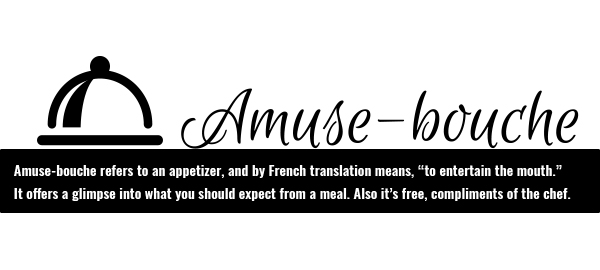Uncategorized
Amuse-bouche: Ketchup
Published
7 years agoon
Posted By
Outlaw Partners
Amuse-bouche refers to an appetizer, and by French translation means, “to entertain the mouth.” It offers a glimpse into what you should expect from a meal. Also it’s free, compliments of the chef.


Chefs live for “cool” ingredients. At least that’s how we have been represented to the public. And for most of us that’s true. But in our ongoing efforts to discover new flavors, ingredients and preparations, sometimes our journey takes us right back to foods and flavors that have been on our taste buds the whole time. And if we’re creative (or silly) enough, we find a whole new purpose for an old familiar friend. As a condiment that can be found in 97 percent of American kitchens, I thought ketchup should have its 15 minutes.
Compared with a sundry of fascinating foods, such as dragon fruit, haggis, saffron and vanilla, ketchup hardly seems interesting. But those are precisely the foods I like to dig deep into, because everything—even the seemingly banal—has a story.
The history of ketchup takes us back to China or Vietnam in A.D. 544, in the form of a fermented fish sauce. Fish sauce is still being made today in almost identical fashion to its ancestor.
There are many flavors of ketchup around the world.
We can divide ketchup’s past into two time periods: pre-tomato and post-tomato. The first tomato ketchup recipe appeared in a cookbook in approximately 1812. Before that, ketchup’s main ingredient was everything from walnuts to berries to oysters and even mushrooms. Of these varieties, mushroom ketchup in particular was immensely popular, and incidentally, became the father of Worcestershire sauce.
Tomato ketchup as we know it today did not appear until 1871, when a man by the name of Henry Heinz got together with a doctor/chemist named Harvey Washington Wiley. Anytime a chemist is involved in the early stages of food development, you probably should avoid it. But maybe that’s just me.
As you might imagine, these two put together quite a concoction containing some questionable preservatives, not the least of which were coal tar and sodium benzoate. The reason for this was that consumers wanted ketchup all year, yet the growing season for tomatoes was only late summer. And while neither of these ingredients are in ketchup today, sodium benzoate is an ingredient in many grocery store provisions.
Heinz and Wiley decided that using spoiled tomatoes as the base, and then adding even more frightful ingredients for preserving was not the answer. Instead, they chose to use higher quality tomatoes to make ketchup in large quantities, and sell it on shelves as a finished product year-round. It was that type of forward thinking that still has Heinz holding 60 percent of the national market and 30 percent of the global ketchup market.
Ever wonder why ketchup seems to take forever to pour out of the bottle? (Think back to the Heinz commercial featuring the Carly Simon song, “Anticipation.”) That is because ketchup is one of the few liquids, food or otherwise, that is categorized as a non-Newtonian fluid.
A non-Newtonian fluid is a liquid whose viscosity fluctuates depending on external forces—like concussing the bottle on the 57 with the palm of your hand. Yep—there is actually some science behind the bottle shape and well-placed 57.
And even though as Americans, we love our apple pie (which is Dutch), and our fireworks (which are of Chinese origins), tomato ketchup is true-blue Americana. But don’t get too prideful just yet. The grand majority of Americans may have a bottle in the fridge, but Canadians consume even more ketchup than we do. Sorry America, we’ll have to find something else to excel at consuming. Spam perhaps?
Scott Mechura has spent a life in the hospitality industry. He is a former certified beer judge and currently the executive chef at Buck’s T-4 Lodge in Big Sky.
The Outlaw Partners is a creative marketing, media and events company based in Big Sky, Montana.


Upcoming Events
november, 2024
Event Type :
All
All
Arts
Education
Music
Other
Sports
Event Details
Spanish Classes with World Language InitiativeThese unique, no cost Spanish classes are made possible by the contribution of Yellowstone Club
more
Event Details
Spanish Classes with World Language InitiativeThese unique, no cost Spanish classes are made possible by the contribution of Yellowstone Club Community Foundation (YCCF) and Moonlight Community Foundation (MCF). This class will focus on building a lifelong affinity for world languages and cultures through dynamic and immersive Communicative Language teaching models.
Beginner Class – Mondays and Wednesdays from 5:30-6:30 pm
Intermediate Class – Mondays and Wednesdays from 6:45- 7:45 pm
- Classes begin Oct.7, 2024 and run for 6 weeks
- Class size is limited to 12 students
- Classes are held in Big Sky at the Big Sky Medical Center in the Community Room
For more information or to register follow the link below or at info@wlimt.org.
Time
October 21 (Monday) 5:30 pm - November 27 (Wednesday) 7:45 pm
Location
Big Sky Medical Center - Community Room (2nd Floor)
Big Sky Medical Center - Community Room (2nd Floor)
Event Details
Spanish Classes with World Language InitiativeThese unique, no cost Spanish classes are made possible by the contribution of Yellowstone Club
more
Event Details
Spanish Classes with World Language InitiativeThese unique, no cost Spanish classes are made possible by the contribution of Yellowstone Club Community Foundation (YCCF) and Moonlight Community Foundation (MCF). This class will focus on building a lifelong affinity for world languages and cultures through dynamic and immersive Communicative Language teaching models.
Beginner Class – Mondays and Wednesdays from 5:30-6:30 pm
Intermediate Class – Mondays and Wednesdays from 6:45- 7:45 pm
- Classes begin Oct.7, 2024 and run for 6 weeks
- Class size is limited to 12 students
- Classes are held in Big Sky at the Big Sky Medical Center in the Community Room
For more information or to register follow the link below or at info@wlimt.org.
Time
October 28 (Monday) 5:30 pm - December 4 (Wednesday) 7:45 pm
Location
Big Sky Medical Center - Community Room (2nd Floor)
Big Sky Medical Center - Community Room (2nd Floor)
Event Details
Spanish Classes with World Language InitiativeThese unique, no cost Spanish classes are made possible by the contribution of Yellowstone Club
more
Event Details
Spanish Classes with World Language InitiativeThese unique, no cost Spanish classes are made possible by the contribution of Yellowstone Club Community Foundation (YCCF) and Moonlight Community Foundation (MCF). This class will focus on building a lifelong affinity for world languages and cultures through dynamic and immersive Communicative Language teaching models.
Beginner Class – Mondays and Wednesdays from 5:30-6:30 pm
Intermediate Class – Mondays and Wednesdays from 6:45- 7:45 pm
- Classes begin Oct.7, 2024 and run for 6 weeks
- Class size is limited to 12 students
- Classes are held in Big Sky at the Big Sky Medical Center in the Community Room
For more information or to register follow the link below or at info@wlimt.org.
Time
November 4 (Monday) 5:30 pm - December 11 (Wednesday) 7:45 pm
Location
Big Sky Medical Center - Community Room (2nd Floor)
Big Sky Medical Center - Community Room (2nd Floor)









